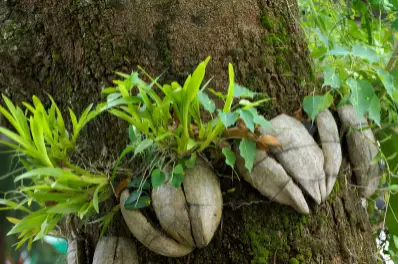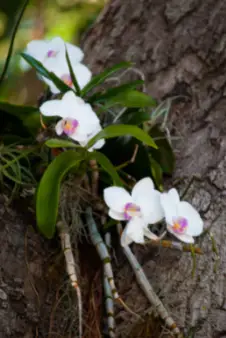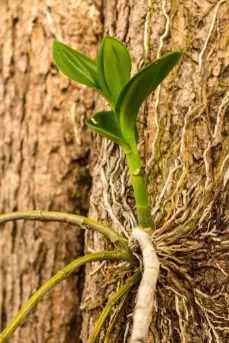If you have ever seen an orchid growing on a tree, you know how alluring this planting style can look. But have you ever wondered what it takes to grow an orchid on a tree on your own? If so, then this article is for you. In the following sections, we’ll reveal an easy way to plant an orchid on a tree and cover the other essential insights you need to do so successfully.
![How to Plant an Orchid on a Tree [4 Easy Steps]](https://wraxly.com/wp-content/uploads/2022/03/How-to-Plant-an-Orchid-on-a-Tree-4-Easy-Steps.jpg)
What Materials Do You Need to Plant an Orchid on a Tree?
Before we begin, let’s make sure that you have all the materials and tools you’ll need. Here is a quick list of the items you should gather before you attempt to plant an orchid on a tree:
- Scissors or Pruning Shears: After removing your orchid from its original container, you may need to trim a few of its roots. Scissors or pruning shears will both work well for the job if they are clean and sharp.
- Moss or Bark: While your orchid secures its roots to the tree, you’ll want to cover it with a growing medium. Sphagnum moss is one of the most common choices for this, but those in warmer regions often use palm tree bark instead.
- Burlap: A piece of burlap will help contain your moss and your orchid’s root system while it establishes itself. The burlap material provides support while permitting air to flow through the roots as needed.
- Cotton String: A big part of planting an orchid on a tree is making sure it is secure and in place. Cotton string is a great item to use to carefully tie parts of your orchid to the tree without harming it.
After you collect those necessary tools, you’re ready to begin the simple process of planting an orchid on a tree. As you’ll soon see, doing so is a matter of completing just a few straightforward steps.

What Kind of Orchids Grow on Trees?
The orchid family is a large and diverse group of plants, with over 25,000 different species. Many of these species are tropical orchids, which can be grown on trees. One of the most popular types of tree-growing orchids is the cattleya orchid, which is native to Central and South America. These orchids typically have large, showy flowers, and come in a wide range of colors. Another type of tree-growing orchid is the hauhinia variegata, which is native to Hawaii. This orchid has small, white flowers with purple markings, and its leaves are often used in leis. With so many different types of tree-growing orchids to choose from, it’s easy to find one that will fit your garden.
How to Plant an Orchid on a Tree in 4 Steps
While the results of growing an orchid on a tree are spectacular, the process to do so is not as challenging as you might guess. In fact, we’ve boiled it down into these four simple steps:
- Remove Your Orchid from its Container
- Locate the Best Place on Your Tree to Plant Your Orchid
- Cover Your Orchid’s Roots with Moss
- Secure Your Orchid to the Tree with String
In the next sections, we’ll share with you the details and considerations you’ll need to make while completing each of those steps. Read on, and soon you’ll be well-prepared to begin growing a gorgeous orchid plant on a tree in your yard.
1) Remove Your Orchid from its Container
The first step when planting an orchid on a tree is to remove your orchid from its current container. Many orchids come in plastic pots that serve as a good temporary growing area. As you remove the plant, you should focus on loosening and spreading the orchid roots. After spending time in a container, many plants can become rootbound and begin to wrap around each other rather than continuing to spread.
Freeing the roots of your orchid plant is especially important when you are planting it on a tree. When an orchid grows in this fashion, it will use its roots as its main form of support and attachment to the tree. If the roots are tangled at the time of your planting, you can’t expect them to form the best possible connection with the tree, which could make it more difficult for your orchid to take hold.
Pull the orchid carefully from its container and use your hand or a hand rake to lightly rough the root mass. As you’ll see, orchids have a set of relatively large, somewhat fleshy roots. Be sure to separate each major root without damaging it. This will give it the greatest chance of adapting to its new growing environment.
Don’t worry too much about losing a lot of the moss in which your orchid was likely growing, as you’ll replace it in a later step. At this stage, you can also choose to trim some of the longer roots. This pruning can help stimulate new growth for the entire root system.

2) Choose the Ideal Tree to Plant Your Orchid On
There is a wide range of tree species on which an orchid can grow, but some options are better than others. We recommend choosing a sturdy and mature tree that can provide a dependable structure on which your orchid can thrive.
It also helps to select a tree with a specific type of rough bark. This will aid the roots of your orchid plant while they attempt to make a connection. Usually, trees that have a bit more texture to their bark, such as a series of ridges and furrows, allow your orchid to get a better grip during establishment.
Your tree needs to be in the right spot, since location matters to the health of your orchid as well. Since you can’t easily move your tree after planting your orchid, you need to make sure it already grows where the conditions are right for an orchid to survive. A bit later in this article, we’ll detail what those conditions are. But for now, just know that the place in which your tree grows is as significant as any other factor.
Lastly, be aware that the specific part of the tree on which you plant your orchid is also of consequence. Orchids can adapt to different locations, including individual branches and the tree trunk. However, a crotch where two major branches diverge is the ideal spot. The fork of a tree provides a broad surface upon which your orchid can secure its roots.
3) Cover Your Orchid’s Roots with Moss
After you set your orchid in its new growing location, the next step is to cover the roots with sphagnum moss. Sphagnum moss is ideal for orchid plants. It allows for good air circulation and good drainage, which lessens the odds of root rot and other complications.
Hold your orchid’s root mass against the tree and cover the exposed sides of the roots entirely with the moss. Once the moss is in place, mounded around the whole root mass, you can wrap it and the tree’s branch with burlap to keep the entire mass in place.
The moss will act as a temporary growing medium while your orchid transitions to depending entirely on the tree and the surrounding air. Often, you won’t need to remove the moss later, as it may decompose on its own by the time your orchid is established.
Recommended Sphagnum Moss Products
4) Secure Your Orchid to the Tree with String
When attaching your orchid to your tree, you should use a soft cotton string to aid the connection. You can wrap the string and some of the orchid roots around your tree branch. It also is helpful to gently tie the stems of the orchid to the branch to keep them upright.
The burlap wrapping you used to contain your sphagnum moss will also need additional support. For this connection, you can use staples to hold the burlap in place. However, this tactic comes at the risk of doing some damage to your tree’s bark. That’s why fishing line or cotton string often proves to be the best option here as well.
While you secure your orchid with a string, remember that these plants are quite fragile. A soft cotton string is the best tying material. However, if you don’t want to damage your plant, a soft string is not enough on its own. You’ll want to make sure that you are very careful while handling your orchid as well to prevent unnecessary harm.
Once your orchid is tied in place, your planting process is essentially complete. Now, it’s time for you to shift your attention to the best ways to provide ongoing care for your orchid.
Ideal Conditions for Growing Orchids on Trees
The steps above will help your plant an orchid on a tree. However, there is more you need to know if you wish to keep your orchid healthy and looking its best. As is true for all plant species, orchids that grow on trees require distinct growing conditions and proper care.
Once you plant an orchid on a tree, you won’t have much chance to move it to a new location. That lack of mobility is the reason why you should select a tree that grows in a place where your orchid can enjoy:
- Indirect light or dappled light: Orchids need a consistent source of light. However, too much light can be detrimental. Avoid the full sun as direct sunlight can quickly harm this plant. Instead, choose the dappled light you’d find below a tree’s canopy.
- High humidity: The tropical orchids that grow on trees need plenty of moisture to survive. Misting yours on a regular basis is a good idea to keep it moist but not overly wet.
- Good air circulation: Orchid roots need excellent air circulation and water drainage. This will help prevent issues related to excess water build-up, including root rot.
- Warm temperatures: The hardiness of an orchid depends on which variety you have. However, it is safe to assume that nearly all orchid species that originate in tropical climates will need warm air temperatures that remain above 50 degrees Fahrenheit. Areas like Southern California and South Florida are two places that consistently have those warmer temperatures.
Caring for an orchid can be difficult and may require close attention to get it right. Both too much and too little water will harm this plant, and the same is true regarding sunlight. But if you can find a suitable location and develop a beneficial maintenance routine, you should have no issue planting and raising an orchid on a tree.

Frequently Asked Questions about Growing Orchids on Trees
Growing orchids on trees is a little unconventional for most. So, let’s clarify a few common questions people have on the topic before we conclude this article.
Since tropical orchids live on trees, many people are quick to assume that they are parasites. However, this is not the case. Orchid roots do not penetrate or damage a tree’s bark in any way. Instead, they attach to the exterior without causing any harm, which is why they are not classified as a parasite species.
Since tropical orchids come from regions that are warm year-round, they tend to produce roots for most of the year. This factor gives you great flexibility in choosing when to plant an orchid on a tree. In general, it is safe to plant an orchid on a tree during any of the warmer months of the year. But for those in hot climates, it may even be possible to plant an orchid in late winter or early spring.
It can take some time before an orchid is fully attached to a tree. In general, it can be one to two years or more before your orchid is fully secure. During that waiting period, your orchid will need to rely on a string or some other material to keep it connected to the tree.
Before planting an orchid on a tree, you need to know about one critical distinction. There are two main types of orchids, terrestrial orchids, and epiphytic orchids. Terrestrial orchids are like most other plants in that they root in the ground and gain their moisture and nutrients from the soil. Epiphytic orchids, like the popular phalaenopsis orchids, are air plants that don’t need soil and instead thrive by attaching to trees.
Since they are a type of air plant, tropical orchids don’t need any soil to continue living. Instead, they can survive thanks to the trees that they attach to. Orchids receive water, nitrogen, and other nutrients directly from the trees on which they grow.
Conclusion
Growing an orchid on a tree in your yard is a unique way to add intrigue to your garden. Thankfully, planting an orchid in this manner is not all that difficult to pull off. All you need to do is follow the advice in the article above, and soon you’ll have a lovely set of orchid flowers growing freely on a tree in your yard.

John Haryasz is a freelance writer and landscape designer. In the field of landscape architecture, he has contributed to many successful design projects throughout the country. As a writer, John specializes in creating captivating and informative web content. Through that work, he aims to share his design knowledge and promote engagement with the outdoor world.

![How to Water Indoor Plants [Plant Care 101]](https://wraxly.com/wp-content/uploads/2021/03/How-to-Water-Indoor-Plants-Plant-Care-101-1200-1024x576.webp)

![Growing Plants from Cuttings [A Simple Guide]](https://wraxly.com/wp-content/uploads/2021/03/Growing-Plants-from-Cuttings-A-Simple-Guide-1200-1024x576.webp)